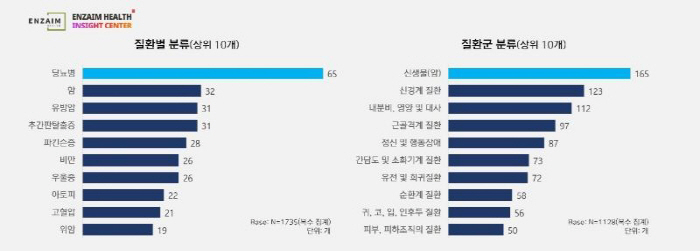A total of 902 activities for 575 diseases by a domestic patient group...165 Most Cancer-Related
Nov 11, 2025
|
According to a survey conducted by the Health Insight Center (Center Director Kang Hyun-woo), run by Enzyme Health, a healthcare PR company, there are a total of 902 patient groups operating online and offline in 575 diseases in Korea, about 7.34 million.
There were 165 patient groups related to neoplasms (cancer), but diabetes (65) related patient groups were the most common single disease. Patient groups have already reached maturity and tend to diversify diseases and increase in scale.
In this survey, the definition of a patient organization was defined as an organization organized to protect the health of patients, fight against disease, and promote rights, as defined in the Framework Act on Patients proposed by 22 lawmakers, including Nam In-soon, in December 2024. Organizations that have not been active in the past year or have clearly revealed commercial purposes, such as advertising, were excluded from the statistics.
From the beginning of the 1990s to 2000, there were only about 20 domestic patient organizations, but through the early and mid-2000s, more than 100 organizations were created every five years, and they grew explosively online and offline. The explosive growth of patient groups in the early 2000s is attributed to the rapid increase in demand for emotional solidarity and information sharing among patients, along with technological advances such as ease of patient aggregation and ensuring anonymity with the development of the digital environment. This trend peaked between 2016 and 2020, but from 2021, growth was decreasing and maturing.
There was also a clear tendency for patient groups to become larger. Of the 788 online and offline patient groups that can check the number of members, 407 (51.5%) were found to have more than 1,000 members, and 126 (15.9%) were found to have more than 10,000 members. In addition, 7.3 million patients participated in patient groups, excluding groups that have not disclosed their membership, indicating that about 14.4% of the Korean population participates in patient groups.
Meanwhile, out of the total 902 patient organizations, unregistered private organizations accounted for 88.2%, while registered and corporate organizations accounted for only 8.7%. The proportion of individuals operating was 77.7%, overwhelming 8.6% of organizations and associations, and 7.8% of hospitals and medical staff. This high rate of unregistered individual operations seems to be due to the ease of opening and operating online patient communities, and these organizations were mainly serving as 'emotional solidarity and information sharing'.
On the other hand, a small number of registered major patient associations, such as the Korea Association of Patient Organizations and the Korea Association of Rare and Intractable Diseases, play an organizational role by focusing on improving health care policies and systems to protect patients' rights and improve the treatment environment, showing a different dual role structure from unregistered private organizations with the main online community characteristics.
◇165 related to neoplasms (cancer) 'best'…The single most common disease is diabetes
As a result of a survey of patient groups by disease and disease group, there were patient groups for 575 diseases, indicating that patient groups for each disease were diversifying.
In detail, diabetes-related patient groups accounted for the largest number of single diseases with 65, followed by cancer (32), breast cancer (31), intervertebral disc escape (31), and Parkinson's disease (28). In terms of the number of patient groups according to the disease group classification, neoplasm (cancer) related patient groups ranked first with 165, followed by nervous system diseases (123), endocrine, nutritional and metabolic diseases (112).
Director of Enzyme Health Insight Center Kang Hyun-woo said, `The explosive growth of domestic patient organizations can paradoxically be seen as the result of a systematic response to the past historical background in which patients' rights were not sufficiently guaranteed within the medical systemThe characteristics of current domestic patient organizations, such as diversification of diseases and enlargement of scale, may not be a simple trend, but a social phenomenon that strongly demands the need for a patient-centered medical environment, he analyzed.
◇The main communication channel is the social community...Up to eight channel organizations
The patient group's main communication channel appeared as a social community channel such as online cafes and bands that facilitated communication activities between members, followed by the use of channels such as homepages and YouTube for external communication. In addition, 10% of patient organizations were found to operate two or more communication channels, and there were even organizations that operated up to eight communication channels.
Unlike active communication channel operations, the rate of disclosure to outsiders other than members of announcements, medical information, and communication boards is about 20-40%, indicating that external access to patient group information is not high.
It can be inferred that due to the nature of patient organizations that mainly share individual disease information and experiences, they tend to operate closed due to concerns about personal information exposure.
Kang Hyun-woo, director of the Enzyme Health Insight Center, said, "This survey is meaningful as the first attempt to specify the role and possibility of the patient organization through data beyond understanding the current status of the patient organization. We hope that this will serve as an opportunity to lay the foundation for cooperation among various stakeholders such as the government, medical industry, and civil society and to improve the patient-centered health care environment."
Meanwhile, the survey was conducted over eight months from March to October at the Enzyme Health Insight Center, which presents data-based insights and solutions centered on health consumers such as patients, and after selecting 11,891 patient groups as the first survey, 902 active patient groups were analyzed along with basic characteristics such as group type, operating entity, and group size.
|
This article was translated by Naver AI translator.















